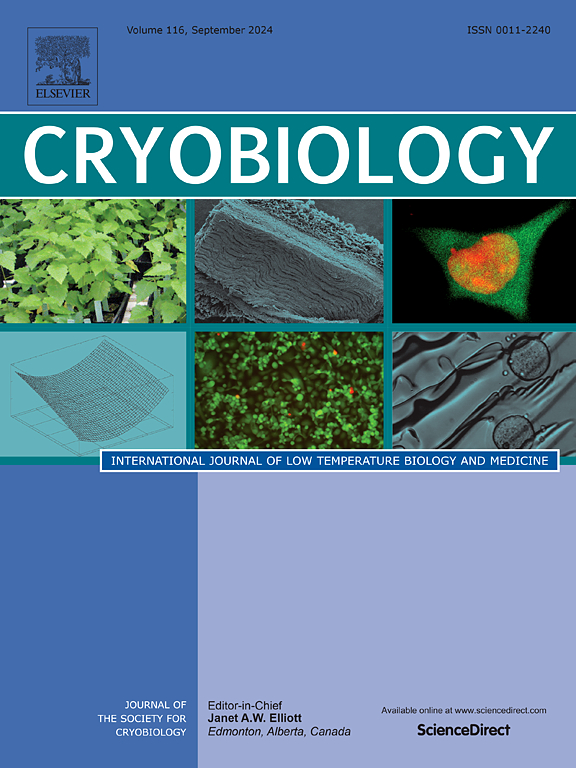Mitochondrial uncoupling and glycolysis stimulation are beneficial for kinematics, functionality and oxidative homeostasis of cryopreserved ram sperm
IF 2.1
3区 生物学
Q2 BIOLOGY
引用次数: 0
Abstract
The aim of the present study was to improve bioenergetics and oxidative status of cryopreserved ram sperm by uncoupling mitochondrial activity and stimulating glycolysis. To verify a potential synergism between mitochondrial uncoupling and glycolysis stimulation, as well as to determine the optimal concentrations of the respective treatments, the study was divided into two experiments. In Experiment 1, ejaculates from eight rams were diluted with the commercial extender (Botubov®), supplemented with the mitochondrial uncoupler CCCP (0, 1, 10, and 20 μM), with or without 5 mM glucose, and then subjected to cryopreservation. After thawing, sperm function and oxidative status analyses were conducted to determine the optimal CCCP concentration, which was selected for Experiment 2. In Experiment 2, ejaculates from seven rams were diluted with the commercial extender (Botubov®) and supplemented with CCCP at doses of 0, 2.5, 5, and 10 μM, with or without 5 mM glucose. After thawing, an analysis of sperm bioenergetics was performed. Differences between treatments were assessed using ANOVA, followed by LSD mean comparison test for the combination of factors. In both experiments, total and progressive motility were higher in the CCCP 10 μM + glucose 5 mM group. This same group exhibited less susceptibility to lipid peroxidation, lower DNA fragmentation (Experiment 1), and greater mitochondrial activity (Experiment 2). Furthermore, treatments with only CCCP were deleterious to sperm. In conclusion, the use of the mitochondrial uncoupler CCCP at a dose of 10 μM combined with 5 mM glucose was promising in improving post-thaw sperm attributes.
线粒体解偶联和糖酵解刺激有利于冻存公羊精子的运动学、功能和氧化稳态
本研究的目的是通过解偶联线粒体活性和刺激糖酵解来改善冷冻保存的公羊精子的生物能量和氧化状态。为了验证线粒体解偶联和糖酵解刺激之间的潜在协同作用,并确定各自处理的最佳浓度,本研究分为两个实验。在实验1中,8只公羊的射精液用Botubov®商用扩展剂稀释,加入线粒体解偶联剂CCCP(0、1、10和20 μM),加入或不加入5 mM葡萄糖,然后冷冻保存。解冻后进行精子功能和氧化状态分析,确定实验2的最佳CCCP浓度。在实验2中,将7只公羊的射精液用Botubov®商业扩展剂稀释,并添加CCCP,剂量分别为0、2.5、5和10 μM,含或不含5 mM葡萄糖。解冻后,进行精子生物能量学分析。采用方差分析(ANOVA)评估治疗间差异,然后对各因素组合进行LSD均值比较检验。在两个实验中,CCCP 10 μM +葡萄糖5 mM组的总运动和进行性运动均较高。同一组小鼠表现出较低的脂质过氧化易感性、较低的DNA片段化(实验1)和较高的线粒体活性(实验2)。此外,仅使用CCCP处理对精子有害。综上所述,使用10 μM剂量的线粒体解耦剂CCCP联合5 mM葡萄糖有望改善解冻后精子的属性。
本文章由计算机程序翻译,如有差异,请以英文原文为准。
求助全文
约1分钟内获得全文
求助全文
来源期刊

Cryobiology
生物-生理学
CiteScore
5.40
自引率
7.40%
发文量
71
审稿时长
56 days
期刊介绍:
Cryobiology: International Journal of Low Temperature Biology and Medicine publishes research articles on all aspects of low temperature biology and medicine.
Research Areas include:
• Cryoprotective additives and their pharmacological actions
• Cryosurgery
• Freeze-drying
• Freezing
• Frost hardiness in plants
• Hibernation
• Hypothermia
• Medical applications of reduced temperature
• Perfusion of organs
• All pertinent methodologies
Cryobiology is the official journal of the Society for Cryobiology.
 求助内容:
求助内容: 应助结果提醒方式:
应助结果提醒方式:


